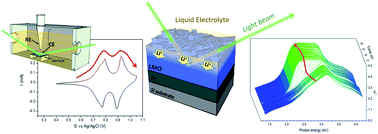Operando probing of Li-insertion into LiMn2O4 cathodes by spectroscopic ellipsometry†
Abstract
A novel non-destructive methodology for operando observation of ion intercalation and the state of charge on battery electrodes is presented based on spectroscopic ellipsometry (SE). The potentiality of this technique for performing time-resolved measurements of (de-)lithiation processes on electrode materials has been demonstrated using thin film spinel LiMn2O4 as a cathode for Li-ion batteries. The chemical diffusivity of Li+ ions in this material has been determined by the time evolution of the Li insertion into the film, and in the light of these results, it has been possible to relate the controversial pseudo-capacitive behavior observed in this material to the nanostructure of the layer. The results presented here establish a new way for operando characterization of battery materials and devices providing a powerful tool for the understanding of ion diffusion mechanisms in a collection of electrochemical devices.



 Please wait while we load your content...
Please wait while we load your content...